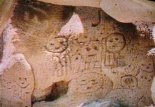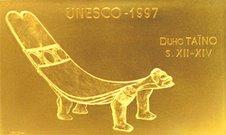by Carmelo Ruiz-Marrero(Alternet, July 13, 2004) - If the American people are for the most part unaware of genetic engineering and food biotechnology issues, the people of Puerto Rico are blissfully in the dark – so far.
Puerto Rico, known for its pineapples and its world-renowned coffee crop, now has a new crop: the biotech harvest.
Much of the genetically engineered (GE) corn and soybean seed planted in the United States comes from this Caribbean island. Furthermore, Puerto Rico is also a preferred location for agricultural biotechnology experiments. According to data from the US Department of Agriculture
When one considers the vast difference in size (Illinois and Iowa have just over 50,000 sq. miles each, whereas Puerto Rico has less than 4,000 sq. miles) it becomes evident that Puerto Rico has more such experiments per square mile than any state, with the possible exception of Hawaii. Puerto Rico also tops California, with 1,709 experiments, although it is approximately 40 times larger than PR and has a vastly larger agricultural output.
These experiments are mostly aimed at the two most widely used GE traits: herbicide resistance (like Roundup Ready crops) and insect control (like the insecticidal Bt corn). But they also include research on biopharmaceutical crops – plants that produce pharmaceutical and industrial chemicals in their tissues – and has also included the controversial “Terminator” crops, which produce sterile seed.
Why Puerto Rico?
The island’s friendly tropical weather permits as many as four harvests per year, making it a favorite for seed breeders for agribusiness and biotechnology corporations like Dow, Syngenta, Pioneer and Monsanto, which got together in 1996 to form the PR Seed Research Association (AISPR).
But another reason for choosing Puerto Rico is its “good political climate.” Puerto Rico is not an independent country, nor is it a state of the American union. It is an “unincorporated territory.” Puerto Ricans are US citizens subject to US laws, yet they cannot vote in presidential elections and have no representation in Congress. There are no anti-biotech campaigns or protesters, not even the mildest criticism. If the American people are for the most part unaware of genetic engineering and food biotechnology issues, the people of Puerto Rico are blissfully in the dark.
Is agricultural biotechnology safe? The US government and the biotech industry argue vehemently that biotech crops and products are safe, are extremely well tested and regulated, and present no new risks to public health or the environment. But many scientists, farmers and environmental NGOs beg to differ.
Genetic Contamination“The Food and Drug Administration (FDA) does not regulate GE foods,” stated the environmental group Friends of the Earth USA (FoE USA) in a report issued in 2003. Instead, says the report, the FDA has a “voluntary consultation” process that allows biotechnology companies to decide which, if any, safety tests to conduct and how they will be performed. “The company determines which data, if any, are shared with regulators. In fact, the company even determines whether it will consult with the FDA at all.”
Other groups, like the UK-based Institute of Science in Society and the US-based Center for Critical Genetics, claim that the scientific assumptions behind genetic engineering are plain wrong and obsolete.
One of the biotech critics’ main concerns is genetic contamination – the uncontrolled proliferation of GE crops through pollination, inventory errors and other means. In late 2002 I gave a presentation at a symposium on biotechnology organized by the Puerto Rico Agricultural Extension Service in which I warned that it is only a matter of time before a biopharmaceutical crop (for example one that produces a powerful pharmaceutical substance) accidentally ends up on supermarket shelves, causing a biological Chernobyl, a public health emergency of horrific and unprecedented nature.
After my talk, Dow corporation representative Victor Torres-Collazo, himself a former AISPR president, respectfully disagreed with me. He assured me that genetic contamination is not a problem because of very strict precautionary measures mandated by law.
But fears of GE contamination are indeed well founded. In 2000, over 300 US supermarket products were found to be tainted with Starlink, a variety of GE corn that the FDA had deemed unfit for human consumption. Some 140 million bushels were contaminated, food processors and grain traders spent around $1 billion over six months trying to locate it and get rid of it, and even today traces of Starlink keep showing up occasionally in American corn exports.
The following year GE corn was discovered growing in Mexico’s rural communities, a development whose long-term consequences for biodiversity, agriculture and human health remain uncertain.
In February 2004 the Union of Concerned Scientists (UCS) unveiled a pilot study that shows that breeders’ varieties of corn, soy, canola and cotton seed in the United States are contaminated with GE material. This means that farmers in the USA – and wherever American seed is exported – could be planting GE seed without knowing it.
“Seeds will be our only recourse if the prevailing belief in the safety of genetic engineering proves wrong,” warns UCS. “Heedlessly allowing the contamination of traditional plant varieties with genetically engineered sequences amounts to a huge wager on our ability to understand a complicated technology that manipulates life at the most elemental level.”
Uncontrolled ExperimentsThe aforementioned genetic experiments in Puerto Rico are not carried out in sealed greenhouses or fermentation vats. “These are outdoor, uncontrolled experiments,” said Bill Freese, of FoE USA. “These experimental GE traits are almost certainly contaminating conventional crops just as the commercialized GE traits are. And the experimental GE crops aren’t even subject to the cursory rubber-stamp ‘approval’ process that commercialized GE crops go through – so I think the high concentration of experimental GE crop trials in Puerto Rico is definitely cause for concern.”
I asked P.R. agriculture secretary Luis Rivero-Cubano if he thought GE crops were any reason for concern. He said that the GE fields here are “just experimental.” The agriculture secretary himself seemed unaware of the massive commercial production of GE seed right here in Puerto Rico.
I then spoke with P.R. Farm Bureau president Ramon Gonzalez, who told a somewhat different story. According to Gonzalez, there are no GE experiments in Puerto Rico; all biotech crops grown here are for commercial use.
Gonzalez himself grows GE corn and soy – for export to the USA as seed – in his farm in the town of Salinas. He claimed to be particularly happy with the soy, which is genetically engineered to be resistant to the Roundup herbicide. He said Roundup is “environmentally benign,” a claim disputed by environmentalists and organic farmers.
Next on my list was the USDA, which has to approve every open-air biotech crop field test. None of Department’s employees seemed to know anything about genetically engineered crops. After an exasperating and fruitless exchange, one of them provided me a USDA phone number in Washington, which turned out to be that of the Meat and Poultry Inspection Service.
The local office of the U.S. Environmental Protection Agency proved no more helpful. Its spokesman Jose Font stated that agriculture does not concern the agency unless toxic pesticides are used.
Finally, I tried the P.R. Environmental Quality Board. No dice. A spokeswoman said that since Puerto Rico has no laws or regulations for GM crops, it has no mandate to intervene or investigate.
Civil society organizations? Forget it. Their leaders have no position on the issue, to the extent that any of them even know what biotech is.
A “good political climate,” indeed.
No protests, no opposition. Not yet, anyway.
Puerto Rican journalist Carmelo Ruiz-Marrero directs the Puerto Rico Project on Biosafety. He is also a Research Associate of the Institute for Social Ecology, a fellow of the Environmental Leadership Program, and a senior fellow of the Society of Environmental Journalists. SEE RELATED ARTICLE AT:http://www.checkbiotech.org/blocks/dsp_document.cfm?doc_id=4093











